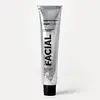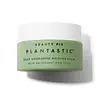What's inside
What's inside
 Key Ingredients
Key Ingredients

 Benefits
Benefits

 Concerns
Concerns

 Ingredients Side-by-side
Ingredients Side-by-side

Water
Skin ConditioningSorbitan Olivate
EmulsifyingCetearyl Olivate
Glyceryl Stearate
EmollientSimmondsia Chinensis Seed Oil
EmollientGlycerin
HumectantCocos Nucifera Oil
MaskingTheobroma Cacao Seed Butter
EmollientAstrocaryum Murumuru Seed Butter
EmollientMauritia Flexuosa Fruit Oil
Skin ConditioningHelianthus Annuus Seed Cera
EmollientCetearyl Alcohol
EmollientGlyceryl Caprylate
EmollientBertholletia Excelsa Seed Oil
EmollientPentaclethra Macroloba Seed Oil
EmollientTheobroma Grandiflorum Seed Butter
Skin ConditioningTocopherol
AntioxidantLavandula Angustifolia Oil
MaskingXanthan Gum
EmulsifyingCetearyl Glucoside
EmulsifyingLinalool
PerfumingCananga Odorata Flower Oil
MaskingSodium PCA
HumectantErythritol
HumectantSorbic Acid
PreservativeBenzoic Acid
MaskingCarrageenan
Limonene
PerfumingBenzyl Benzoate
AntimicrobialAscorbyl Palmitate
AntioxidantGeraniol
PerfumingFarnesol
PerfumingBenzyl Salicylate
PerfumingGlucose
HumectantWater, Sorbitan Olivate, Cetearyl Olivate, Glyceryl Stearate, Simmondsia Chinensis Seed Oil, Glycerin, Cocos Nucifera Oil, Theobroma Cacao Seed Butter, Astrocaryum Murumuru Seed Butter, Mauritia Flexuosa Fruit Oil, Helianthus Annuus Seed Cera, Cetearyl Alcohol, Glyceryl Caprylate, Bertholletia Excelsa Seed Oil, Pentaclethra Macroloba Seed Oil, Theobroma Grandiflorum Seed Butter, Tocopherol, Lavandula Angustifolia Oil, Xanthan Gum, Cetearyl Glucoside, Linalool, Cananga Odorata Flower Oil, Sodium PCA, Erythritol, Sorbic Acid, Benzoic Acid, Carrageenan, Limonene, Benzyl Benzoate, Ascorbyl Palmitate, Geraniol, Farnesol, Benzyl Salicylate, Glucose
Water
Skin ConditioningGlycerin
HumectantSimmondsia Chinensis Seed Oil
EmollientCetearyl Alcohol
EmollientButyrospermum Parkii Butter
Skin ConditioningRicinus Communis Seed Oil
MaskingCetyl Alcohol
EmollientCocos Nucifera Oil
MaskingSodium Polyacrylate
AbsorbentGlyceryl Stearate
EmollientSesamum Indicum Seed Oil
EmollientSorbitol
HumectantPhenoxyethanol
PreservativeHydrogenated Polydecene
EmollientParfum
MaskingXanthan Gum
EmulsifyingEthylhexylglycerin
Skin ConditioningAstrocaryum Murumuru Seed Butter
EmollientChlorphenesin
AntimicrobialTrideceth-6
EmulsifyingDisodium EDTA
Linum Usitatissimum Seed Oil
PerfumingLinalool
PerfumingGeraniol
PerfumingPEG-8
HumectantLimonene
PerfumingTocopherol
AntioxidantCitral
PerfumingAscorbyl Palmitate
AntioxidantCI 19140
Cosmetic ColorantAscorbic Acid
AntioxidantCitric Acid
BufferingSolanum Lycopersicum Leaf Cell Culture Extract
Skin ConditioningCI 16035
Cosmetic ColorantWater, Glycerin, Simmondsia Chinensis Seed Oil, Cetearyl Alcohol, Butyrospermum Parkii Butter, Ricinus Communis Seed Oil, Cetyl Alcohol, Cocos Nucifera Oil, Sodium Polyacrylate, Glyceryl Stearate, Sesamum Indicum Seed Oil, Sorbitol, Phenoxyethanol, Hydrogenated Polydecene, Parfum, Xanthan Gum, Ethylhexylglycerin, Astrocaryum Murumuru Seed Butter, Chlorphenesin, Trideceth-6, Disodium EDTA, Linum Usitatissimum Seed Oil, Linalool, Geraniol, PEG-8, Limonene, Tocopherol, Citral, Ascorbyl Palmitate, CI 19140, Ascorbic Acid, Citric Acid, Solanum Lycopersicum Leaf Cell Culture Extract, CI 16035
 Reviews
Reviews

Ingredients Explained
These ingredients are found in both products.
Ingredients higher up in an ingredient list are typically present in a larger amount.
Ascorbyl Palmitate is created by combining pure Vitamin C and palmitic acid. It is an antioxidant and helps reduce hyperpigmentation.
This ingredient is a more stable version of Vitamin C, meaning it does not disintegrate as quickly when exposed to sunlight. However, studies show it does not penetrate skin as well as pure Vitamin C.
Ascorbyl Palmitate is oil soluble.
Read more about other types of Vitamin C:
Learn more about Ascorbyl PalmitateAstrocaryum Murumuru Seed Butter isn't fungal acne safe.
Cetearyl alcohol is a mixture of two fatty alcohols: cetyl alcohol and stearyl alcohol. It is mainly used as an emulsifier. Emulsifiers help prevent the separation of oils and products. Due to its composition, it can also be used to thicken a product or help create foam.
Cetearyl alcohol is an emollient. Emollients help soothe and hydrate the skin by trapping moisture.
Studies show Cetearyl alcohol is non-toxic and non-irritating. The FDA allows products labeled "alcohol-free" to have fatty alcohols.
This ingredient is usually derived from plant oils such as palm, vegetable, or coconut oils. There is debate on whether this ingredient will cause acne.
Due to the fatty acid base, this ingredient may not be Malassezia folliculitis safe.
Learn more about Cetearyl AlcoholCocos Nucifera Oil is obtained from the kernels of the coconut fruit. In other words, this is coconut oil.
Coconut Oil is rich in fatty acids with lauric acid making up the majority of these. It also contains linoleic acid. Due to this high fatty acid content, coconut oil helps trap moisture and soften skin.
Despite being antibacterial, coconut oil may not be great for acne-prone skin. It is comedogenic and may clog pores. This ingredient may not be safe for malassezia or fungal acne.
Note: Coconut Oil should not replace your sunscreen for UV protection. Studies show it only blocks about 20% of UV.
This oil is non-volatile and has a light scent.
The term 'fragrance' is not regulated in many countries. In many cases, it is up to the brand to define this term. For instance, many brands choose to label themselves as "fragrance-free" because they are not using synthetic fragrances. However, their products may still contain ingredients such as essential oils that are considered a fragrance.
Learn more about Cocos Nucifera OilGeraniol is used to add fragrance/parfum to a product. It is the main component of citronellol. It is a monoterpenoid and an alcohol.
Monoterpenes are naturally found in many parts of different plants.
Geraniol can be found in many essential oils including Rose Oil and Citronella Oil. The scent of Geraniol is often described as "rose-like". Many foods also contain Geraniol for fruit flavoring.
Geraniol can irritate the skin when exposed to air. However, irritation depends on the ability of geraniol to penetrate into the skin. In general, geraniol is not able to penetrate skin easily.
Geraniol is colorless and has low water-solubility. However, it is soluble in common organic solvents.
Like citronellol, it is a natural insect repellent.
2,6-Octadien-1-ol, 3,7-dimethyl-, (2E)-
Learn more about GeraniolGlycerin is already naturally found in your skin. It helps moisturize and protect your skin.
A study from 2016 found glycerin to be more effective as a humectant than AHAs and hyaluronic acid.
As a humectant, it helps the skin stay hydrated by pulling moisture to your skin. The low molecular weight of glycerin allows it to pull moisture into the deeper layers of your skin.
Hydrated skin improves your skin barrier; Your skin barrier helps protect against irritants and bacteria.
Glycerin has also been found to have antimicrobial and antiviral properties. Due to these properties, glycerin is often used in wound and burn treatments.
In cosmetics, glycerin is usually derived from plants such as soybean or palm. However, it can also be sourced from animals, such as tallow or animal fat.
This ingredient is organic, colorless, odorless, and non-toxic.
Glycerin is the name for this ingredient in American English. British English uses Glycerol/Glycerine.
Learn more about GlycerinGlyceryl Stearate is a mix of glycerin and stearic acid.
It is used to stabilize the mixing of water and oil ingredients. By preventing these ingredients from separating, it can help elongate shelf life. It can also help thicken the product's texture.
As an emollient, it helps soften skin and supports barrier-replenishing ingredients.
In cosmetics, Glyceryl Stearate is often made from vegetable oils or synthetically produced.
This ingredient may not be fungal-acne safe
Fun fact: The human body also creates Glyceryl Stearate naturally.
Learn more about Glyceryl StearateLimonene is a fragrance that adds scent and taste to a formulation.
It's found in the peel oil of citrus fruits and other plants such as lavender and eucalyptus. The scent of limonene is generally described as "sweet citrus".
Limonene acts as an antioxidant, meaning it helps neutralize free radicals.
When exposed to air, oxidized limonene may sensitize the skin. Because of this, limonene is often avoided by people with sensitive skin.
The term 'fragrance' is not regulated in many countries. In many cases, it is up to the brand to define this term. For instance, many brands choose to label themselves as "fragrance-free" because they are not using synthetic fragrances. However, their products may still contain ingredients such as essential oils that are considered a fragrance.
Learn more about LimoneneLinalool is a fragrance and helps add scent to products. It's derived from common plants such as cinnamon, mint, citrus, and lavender.
Like Limonene, this ingredient oxidizes when exposed to air. Oxidized linalool can cause allergies and skin sensitivity.
This ingredient has a scent that is floral, spicy tropical, and citrus-like.
Learn more about LinaloolThis oil comes from the seeds of the desert shrub called Jojoba. It is more commonly known as jojoba oil, a non-comedogenic oil.
Jojoba oil does not contain fragrance and has many fatty-acids, making it a great soothing ingredient.
It also contains Vitamin E, a great moisturizing ingredient. Vitamin E is also an antioxidant and protects your skin against oxidative damage.
This ingredient humectant properties, meaning it helps draw moisture from the air. This helps keep your skin hydrated.
While jojoba has antibacterial properties, it is only able to kill some strains of bacteria.
Studies also show it helps in wound healing. In fact, Indigenous cultures have used jojoba as a moisturizer and to help treat burns for centuries.
Fun fact: Jojoba oil similar to natural human skin sebum, so it has a great effect on dry skin. It is also promising with helping to regulate sebum production.
Due to its fatty acid content, Jojoba oil may not be fungal acne safe. We recommend speaking with a professional if you have any concerns.
Learn more about Simmondsia Chinensis Seed OilTocopherol (also known as Vitamin E) is a common antioxidant used to help protect the skin from free-radicals and strengthen the skin barrier. It's also fat soluble - this means our skin is great at absorbing it.
Vitamin E also helps keep your natural skin lipids healthy. Your lipid skin barrier naturally consists of lipids, ceramides, and fatty acids. Vitamin E offers extra protection for your skin’s lipid barrier, keeping your skin healthy and nourished.
Another benefit is a bit of UV protection. Vitamin E helps reduce the damage caused by UVB rays. (It should not replace your sunscreen). Combining it with Vitamin C can decrease sunburned cells and hyperpigmentation after UV exposure.
You might have noticed Vitamin E + C often paired together. This is because it is great at stabilizing Vitamin C. Using the two together helps increase the effectiveness of both ingredients.
There are often claims that Vitamin E can reduce/prevent scarring, but these claims haven't been confirmed by scientific research.
Learn more about TocopherolWater. It's the most common cosmetic ingredient of all. You'll usually see it at the top of ingredient lists, meaning that it makes up the largest part of the product.
So why is it so popular? Water most often acts as a solvent - this means that it helps dissolve other ingredients into the formulation.
You'll also recognize water as that liquid we all need to stay alive. If you see this, drink a glass of water. Stay hydrated!
Learn more about WaterXanthan gum is used as a stabilizer and thickener within cosmetic products. It helps give products a sticky, thick feeling - preventing them from being too runny.
On the technical side of things, xanthan gum is a polysaccharide - a combination consisting of multiple sugar molecules bonded together.
Xanthan gum is a pretty common and great ingredient. It is a natural, non-toxic, non-irritating ingredient that is also commonly used in food products.
Learn more about Xanthan Gum